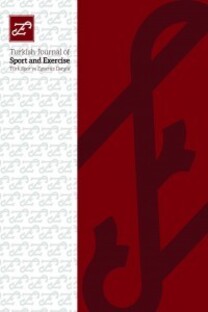A movable technological simulation system for kinematic analysis to provide immediate accurate feedback and predict javelin throw distance
A movable technological simulation system for kinematic analysis to provide immediate accurate feedback and predict javelin throw distance
___
- 1. Adamczewski H. Untersuchungsergebnisse vom Messplatz Speerwurf. Die Lehre der Leichtathletik, 1995; 17: 97-100.
- 2. Ballreich R, Kuhlow A. (1986): Biomechanik des Kugelstoss, In: Ballreich, A, Bionnechanik der Sportarten, Ferdinand Enke Verlag, Stottgart, 1986; 89-109.
- 3. Bartonietz K. Zur Sportlichen Technik der Wettkampfübungen und zur Wirkungsrichtung Ausgewählter Trainingsübungen in den Wurf- und Stoßdisziplinen der Leichtathletik. Leipzig: Univ., Diss, 1987; 23, 57.
- 4. Bauersfeld KH, Schröter G. Grundlagen der Leichtathletik, 5. Aufl., Sport und Gesundheit verlag, Berlin, 1998; 299. 5. Bortz J. Statistik für Sozialwissenschaftler, 6 Aufl., Springer Verlag, Berlin, 2005.
- 6. Daugs R. Evaluation sportmotorischen Messplatztrainings im Spitzensport, 1. Aufl., Sport und Buch strauß, Köln, 2000; 38. 7. Farfel VS. Bewegungssteuerung im Sport, Berlin, 1977.
- 8. Geese R. Technisch- apparative Möglichkeiten zur Leistungsdiagnostik und -steuerung mittels objektiver Schnellinformation, Leistungssport, Nr. 2, 1992; 31-33.
- 9. Grosser M, Neumaier A. Techniktraining, Theorie und Praxis aller Sportarten, BLV Verlagsgesellschaft, München, 1982; 81, 84.
- 10. Hinz L. Leichtathletik, Wurf und Stoss, 1. Aufl., Sportverlag, Berlin, 1991; 15-18, 20.
- 11. Hodges NJ, Franks IM. Modelling coaching practice: the role of instruction and demonstration. Journal of Sports Sciences, 2002; 20: 793-811.
- 12. Jenoptik. Laser, Optik, Systeme GmbH, Distanz-Auswertung 'SPORT', Programm- Beschreibung Version 3.7, Jena, 2000.
- 13. Joch W. Rahmentrainingsplan für das Aufbautraining, Wurf, 2. Auflage, Meyer & Meyer Verlag, Aachen, 1993; 172.
- 14. Jonath U, Krempel R, Haag E, Müller H. Leichtathletik 3, Werfen und Mehrkampf, Rowohlt Verlag, Hamburg, 1995; 132, 157.
- 15. Köllner J, Dörr J, Wiese G. Der Einsatz von Mess- und Bürocomputertechnik am Krafttrainingsgerät Speerwurf zur Bereitstellung von Sofortinformationen im Training, Theorie und Praxi Leistungssport, Nr. 2, 1989; 54-63.
- 16. Morriss CJ, Bartlett RM. Biomechanical factors critical for performance in the javelin throw. In: Sports Medicine 1996; 21(6): 438-446.
- 17. Rohland U. Statistik, Erläuterung grundlegender Begriffe und Verfahren, Shaker Verlag, Aachen, 2000; 48.
- 18. Salmoni A, Schmidt RA, Walter CB. Knowledge of results and motor learning: a review and critical reappraisal. Psychological Bulletin, 1984; 95: 355- 386.
- 19. Schmidt RA, Lange C, Young DE. Optimizing summary knowledge of results for skill learning. Human Movement Science, 1990; 9: 325- 348.
- 20. Schmucker U, Warnemünde R, Ritschel M. Digitaler Wurfspeer- Beschleunigungs- und Geschwindigkeitsmessung im Leistungssport, Leistungssport, Nr. 5, 2001; 32-34.
- 21. Schwuchow H. Anforderungen an die Charakteristik des finalen Krafteinsatzes zum Erreichen der Prognoseleistungen im Speerwurf, Diplomarbeit, Leipzig Univ., 1986; 11,12.
- 22. Shea CH, Wulf G. Enhancing motor learning through external-focus instructions and feedback. Human Movement Science, 1999; 18: 553- 571.
- 23. Thorhauer HA. Zur Zeitstruktur der objektiven ergänzenden Schnell- Information Theorie und Praxis der Körperkultur, 1971; 390.
- 24. Tünnemann H, Freyer K. Diagnostik und Training technikorientierter Kraftfähigkeiten mittels ringkampfspezifischer Bewegungssimulatoren, Institut für Angewandte Trainingswissenschaft (Hrsg.), Meyer & Meyer Verlag, Leipzig, Nr. 3, 1995; 105-121.
- 25. Tutjowitsch VN. Theorie der sportlichen Würfe, Teil 1, Informationen zum Training, Beiheft zu Leistungssport, 1969; 3, 9f.
- 26. Viitasalo J, Korjus T. Messung der Abwurfgeschwindigkeit und des Abwurfwinkels beim Speerwurf, Leistungssport, Nr. 4, 1987; 39-41.
- 27. Winstein CJ, Schmidt RA. Reduced frequency of knowledge of results enhances motor skill learning. Journal of Experimental Psychology: Learning, Memory and Cognition, 1990; 16: 677-691.
- Yayın Aralığı: 3
- Başlangıç: 1999
- Yayıncı: Selçuk Üniversitesi, Spor Bilimleri Fakültesi
Cengiz TASKIN, Onder KARAKOC, Ahmet SANIOGLU, Mine TASKIN
An examination of anger levels of the individuals doing extreme sport
Merve CEYLAN, Fahri AKCAKOYUN, Vedat MUTLU
Ehsan ZAREIAN, Majid ARAB, Karen BARANI, Mehdi DASTFAL
Alireza ZAMANI, Saeid ROSTAMI, Bijan RAJAEIAN
Among the reasons for the importance of sports on holiday
Murat SENTUNA, Cenk TEMEL, Velittin BALCI
Hulya UNLU, Pinar GUZEL, Melike ESENTAS, Selhan OZBEY
An overview of the professional conditions of the football referees in Turkey
